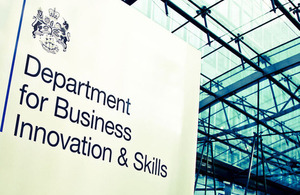New aerospace HQ fires up technology drive
A new aerospace headquarters that will help allocate £2 billion of funding to projects across the country has opened today (25 April 2014).

A new aerospace headquarters that will help allocate £2 billion of funding to research and technology projects across the country has opened today (25 April 2014).
Business Minister Michael Fallon hailed the groundbreaking initiative at the official opening of the headquarters of the Aerospace Technology Institute (ATI) in Cranfield, Bedfordshire.
The ATI is a major commitment in the government’s Industrial Strategy, established to keep the UK at the forefront of the global aerospace sector. The new institute will oversee the UK’s technology strategy for the next generation of quieter, more energy efficient aircraft.
Gary Elliott, former CEO of Hybrid Air Vehicles, has today (25 April 2014) been appointed Chief Executive of the ATI.
Michael Fallon also visited the Aircraft Research Association (ARA) in Bedford. ARA is to benefit from £2 million of ATI funding to enhance its capability to carry out wind tunnel research and testing. This work could lead to increased passenger comfort and less noise due to the lower impact of turbulence.
ARA’s wind tunnels will enable aerospace companies to conduct advanced research in the early stages of the development of new aircraft and helicopters. The testing section of the tunnel measures 8ft by 9ft; uses power equivalent to the town of Bedford when it is running; and runs at up to 1,000 mph, 1.3 times the speed of sound.
Business Minister Michael Fallon said:
The UK has the number 1 aerospace industry in Europe. I want to make sure we keep it that way.
This headquarters at Cranfield is 1 of many new projects supported by Aerospace Technology Institute funding. By supporting partnerships between companies and universities across the UK, we are building the high-grade skills and technologies that will drive sustained growth.
The government’s Industrial Strategy will give the industry the long-term certainty it needs to stay competitive and create jobs, and will ensure the UK remains 1 of the world’s most attractive locations for aerospace manufacturing.
The ATI will help ensure maximum return from £2 billion joint government and industry investment provided through the Industrial Strategy by providing a single, national focus for technology research and facilities in the sector.
Improvements enabled by the ATI are expected to lead to a reduction in CO2 emissions of more than 100 million tonnes each year from next generation aircraft - equivalent to taking 20 million cars off the road around the world.
The UK’s aerospace sector contributes £24 billion to the economy every year, supports 3,000 companies and employs 230,000 workers across the UK. Three quarters of the industry’s product is exported.
Notes to editors
-
Gary Elliott was previously CEO at Hybrid Air Vehicles. Before this, he held roles at Lloyds Banking Group, NG Bailey and BAE Systems. He has a BEng in Aeronautics from Queen’s University Belfast and an MBA from the Cranfield school of Management.
-
Stephen Henwood CBE was appointed as Independent Chair of the ATI in February 2014.
-
‘Lifting off’ is the government’s Industrial Strategy for aerospace.
-
The government’s economic policy objective is to achieve ‘strong, sustainable and balanced growth that is more evenly shared across the country and between industries’. It set 4 ambitions in the ‘Plan for Growth’:
- to create the most competitive tax system in the G20
- to make the UK the best place in Europe to start, finance and grow a business
- to encourage investment and exports as a route to a more balanced economy
- to create a more educated workforce that is the most flexible in Europe
Work is underway across government to achieve these ambitions, including progress on more than 250 measures as part of the Growth Review. Developing an Industrial Strategy gives new impetus to this work by providing businesses, investors and the public with more clarity about the long-term direction in which the government wants the economy to travel.